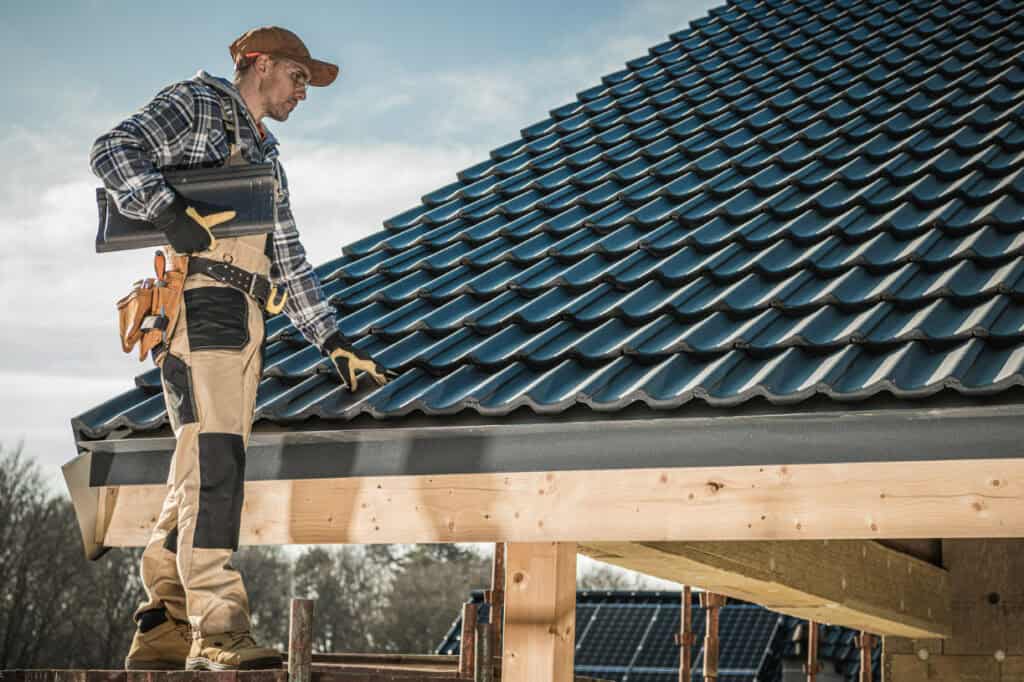Your roof stands as the first line of defense against the elements, safeguarding your home from rain, wind, snow, and sun. It’s not just a simple cover but a shield that protects your family and belongings from adverse weather conditions. Maintaining your roof year-round is crucial for ensuring its longevity and protecting your property.
Table of Contents
Regular maintenance helps to identify potential problems early, preventing small issues from turning into significant, costly repairs. From inspections to repairs, a proactive approach can save you from costly damages down the line.
Here, we’ll delve into expert tips for maintaining your roof year-round, keeping it in top condition throughout the seasons, including how to conduct a basic inspection, what signs to look for that indicate potential damage, and the best times of year to perform routine maintenance tasks.

Regular Inspections
Regular inspections form the cornerstone of roof maintenance, ensuring the longevity and durability of your roofing system. Schedule inspections at least twice a year, ideally in the spring and fall, to catch any issues before they escalate into costly repairs.
During these inspections, look for signs of damage such as missing shingles, cracked tiles, or sagging areas that could compromise the roof’s structure. Additionally, check for debris buildup in gutters and around roof vents, as this can lead to water damage and other problems.

If you’re uncertain about conducting an inspection yourself, consider hiring a professional roofing contractor. Reputable roofing companies offer premium roofing solutions and can provide thorough assessments of your roof’s condition.
They have the expertise to identify potential problems that you might overlook and can recommend appropriate solutions to maintain your roof’s health. Regular professional inspections not only give you peace of mind but also extend the lifespan of your roof, protecting your home from the elements for years to come.
Clearing Debris
Debris accumulation on your roof can lead to a host of problems, including water pooling, mold growth, and even structural damage. When leaves, branches, and other debris clog your gutters, water cannot drain properly, leading to leaks and water damage inside your home.
Regularly clear leaves, branches, and other debris from your roof and gutters to prevent these issues. Use a roof rake to safely remove debris or hire professionals for thorough cleaning, especially after heavy storms or during the fall when leaves are abundant.
Additionally, it’s important to inspect your roof periodically for any signs of wear and tear, such as missing shingles or damaged flashing, which can exacerbate the effects of debris accumulation.
Keeping your roof clear of debris is essential for maintaining its integrity and prolonging its lifespan, ensuring that it can protect your home effectively for many years to come. By taking these preventive measures, you can save yourself from costly repairs and maintain a safe, secure home environment.
Repairing Damage Promptly
Addressing minor issues promptly can prevent them from escalating into major problems. Whether it’s a small leak or a damaged shingle, don’t postpone repairs. Ignoring minor damage can result in water infiltration, mold growth, and structural weakening, which can ultimately lead to costly and extensive repairs.
For instance, a small leak might seem insignificant initially but can deteriorate the insulation and drywall over time, causing significant damage. If you’re not comfortable tackling repairs yourself, enlist the help of a qualified roofing contractor.
These professionals have the expertise and tools necessary to handle various roofing issues efficiently. They can assess the extent of the damage, identify potential underlying problems, and provide effective solutions to restore your roof’s integrity.
Moreover, regular maintenance checks by a professional can help detect issues early, ensuring your roof remains in optimal condition for years to come.
Proper Ventilation and Insulation
Proper ventilation and insulation are vital for maintaining a healthy roof and preventing moisture-related issues. Without adequate ventilation, heat and moisture can build up in your attic, leading to problems such as mold growth, wood rot, and reduced lifespan of roofing materials.
Ensure that your attic is well-ventilated to allow for air circulation, which helps regulate temperature and moisture levels. This can be achieved through the installation of ridge vents, soffit vents, or attic fans.
Adequate insulation also plays a crucial role in energy efficiency and preventing ice dams during the winter months. Insulation helps to keep your home warm in the winter and cool in the summer, reducing energy costs and improving comfort levels.
Additionally, proper insulation prevents heat from escaping through the roof, which can cause snow to melt and refreeze, leading to ice dams that can damage the roof and gutters.
To ensure your attic has the right balance of ventilation and insulation, consult with a professional roofer who can assess your specific needs and recommend appropriate solutions. Investing in these improvements not only protects your roof but also enhances the overall energy efficiency and health of your home.
Tree Maintenance
Trees can enhance the beauty of your property, providing shade, aesthetic appeal, and even boosting your home’s value. However, they can also pose a threat to your roof if not properly maintained.
Overhanging branches can scrape against the roof surface, leading to shingle damage and debris buildup, which can clog gutters and lead to water damage. Trim back branches that are in close proximity to your roof to prevent these issues.
Additionally, keep an eye out for dead or diseased trees that may pose a risk of falling onto your roof during storms, which can cause significant structural damage.
Regular tree maintenance, such as pruning, trimming, and inspecting the health of the trees, can help protect your roof and prolong its lifespan, ensuring that your home remains safe and aesthetically pleasing.
Snow and Ice Management
In regions prone to snow and ice, proper snow and ice management are essential for preventing roof damage and leaks.
Heavy snow and ice accumulation can put significant stress on your roof, leading to potential structural issues. Use a roof rake to safely remove excess snow buildup, especially after heavy snowfall, to reduce the weight and pressure on your roof.
Additionally, consider installing heating cables or ice melt systems along the roof edges to prevent ice dams from forming, which can cause water to back up under shingles and lead to leaks.
It’s also advisable to inspect your roof regularly during the winter months for any signs of damage or areas where snow and ice are accumulating unevenly. These proactive measures can help minimize the risk of water infiltration and structural damage, ensuring your home remains safe and secure throughout the winter season.
Professional Maintenance Programs
Many roofing companies offer professional maintenance programs designed to keep your roof in optimal condition year-round. These programs typically include regular inspections, thorough cleaning, and minor repairs to address issues before they worsen, thereby preventing costly damages in the future.
Often, these inspections involve checking for loose or damaged shingles, inspecting the flashing, and ensuring the drainage systems are clear and functional. Enrolling in a maintenance program can provide peace of mind knowing that your roof is being cared for by experts who are trained to spot potential problems early on.
Additionally, some programs may offer emergency services and priority scheduling for repairs. Consider investing in such a program to ensure the long-term health and durability of your roof, protecting your home and your investment for years to come.
Storm Preparedness
Severe weather events can wreak havoc on your roof, so it’s essential to be prepared. Before storm season hits, inspect your roof for any existing damage, such as missing shingles, leaks, or weakened structures, and make necessary repairs to ensure its integrity.
Trim back trees and branches that overhang your roof, as these can cause significant damage if they break off during high winds. Secure loose objects around your property that could become dangerous projectiles in high winds, such as patio furniture, grills, and garden tools.
Additionally, consider investing in impact-resistant roofing materials, which are designed to withstand damage from hail and flying debris, thereby minimizing potential harm to your home.
Being proactive and prepared can help mitigate the impact of storms on your roof and property, ultimately saving you time, money, and stress in the aftermath of severe weather.
Monitoring Roof Aging
Like any other component of your home, your roof will naturally age over time. Monitoring its condition and proactively addressing signs of aging can help prolong its lifespan. Keep an eye out for signs of wear and tear such as curling shingles, granule loss, and water stains on ceilings, which can indicate underlying issues.
Regular inspections, especially after severe weather, can help identify problems early. If your roof is approaching the end of its lifespan, consider investing in a roof replacement to avoid costly repairs and potential water damage.
A new roof not only enhances the safety and comfort of your home but also adds to its aesthetic appeal and market value. Proper maintenance, including cleaning debris from gutters and ensuring adequate ventilation, can further extend the roof’s durability.

Maintaining your roof year-round is essential for protecting your home and investment. By following these expert tips, you can prolong the lifespan of your roof and avoid costly repairs.
From regular inspections to proactive maintenance, investing time and effort in caring for your roof will pay off in the long run. Remember, when it comes to roof maintenance, prevention is key. So, don’t wait until problems arise—take action now to ensure your roof remains in top condition for years to come.
Maintaining Your Roof Year-Round – FAQs
- How often should I have my roof inspected?
- It’s recommended to have your roof inspected at least twice a year, ideally in the spring and fall. Additionally, inspections should be conducted after severe weather events to check for any potential damage.
- Can I perform roof maintenance myself, or should I hire a professional?
- While some basic maintenance tasks, such as clearing debris and checking for obvious damage, can be performed by homeowners, it’s advisable to hire a professional roofing contractor for thorough inspections and repairs. Professionals have the expertise and equipment needed to safely and effectively maintain your roof.
- What are the signs that my roof needs to be replaced?
- Common signs that your roof may need replacement include curling or missing shingles, granule loss, water stains on your ceilings, frequent leaks, and the roof reaching the end of its expected lifespan (typically 20-30 years for asphalt shingles).
- What should I do if I notice a leak in my roof?
- If you notice a leak, it’s important to address it promptly to prevent further damage. Cover the area with a tarp to stop water infiltration and contact a roofing professional to assess and repair the damage as soon as possible.
- How can I improve my roof’s energy efficiency?
- Improving your roof’s energy efficiency can be achieved through proper insulation and ventilation. Ensure that your attic is well-insulated and ventilated to regulate temperature and moisture levels. Additionally, consider using energy-efficient roofing materials that reflect more sunlight and reduce heat absorption.



